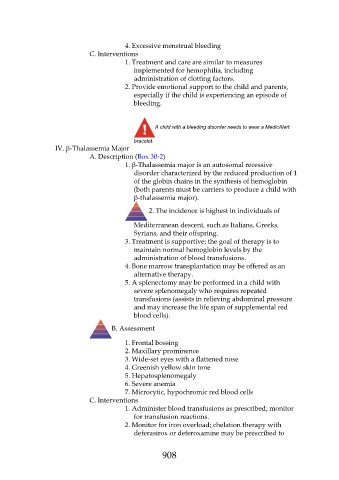Page 908 - Saunders Comprehensive Review For NCLEX-RN
P. 908
4. Excessive menstrual bleeding
C. Interventions
1. Treatment and care are similar to measures
implemented for hemophilia, including
administration of clotting factors.
2. Provide emotional support to the child and parents,
especially if the child is experiencing an episode of
bleeding.
A child with a bleeding disorder needs to wear a MedicAlert
bracelet.
IV. β-Thalassemia Major
A. Description (Box 30-2)
1. β-Thalassemia major is an autosomal recessive
disorder characterized by the reduced production of 1
of the globin chains in the synthesis of hemoglobin
(both parents must be carriers to produce a child with
β-thalassemia major).
2. The incidence is highest in individuals of
Mediterranean descent, such as Italians, Greeks,
Syrians, and their offspring.
3. Treatment is supportive; the goal of therapy is to
maintain normal hemoglobin levels by the
administration of blood transfusions.
4. Bone marrow transplantation may be offered as an
alternative therapy.
5. A splenectomy may be performed in a child with
severe splenomegaly who requires repeated
transfusions (assists in relieving abdominal pressure
and may increase the life span of supplemental red
blood cells).
B. Assessment
1. Frontal bossing
2. Maxillary prominence
3. Wide-set eyes with a flattened nose
4. Greenish yellow skin tone
5. Hepatosplenomegaly
6. Severe anemia
7. Microcytic, hypochromic red blood cells
C. Interventions
1. Administer blood transfusions as prescribed; monitor
for transfusion reactions.
2. Monitor for iron overload; chelation therapy with
deferasirox or deferoxamine may be prescribed to
908

